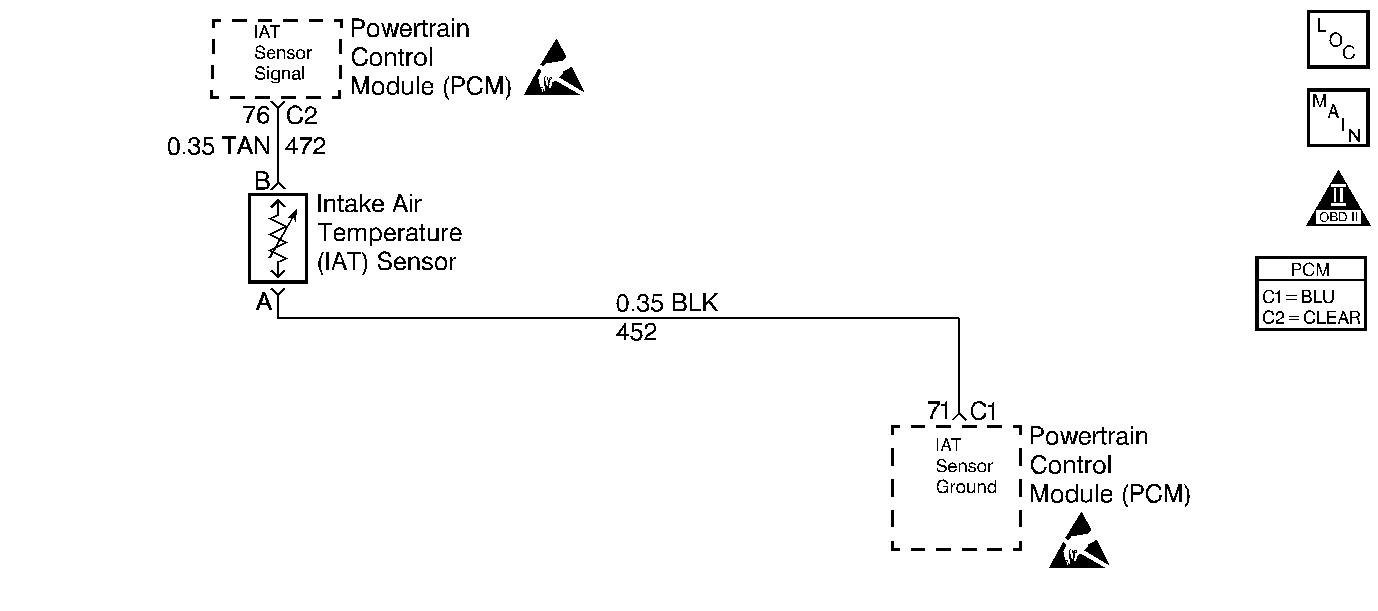
Circuit Description
The Intake Air Temperature sensor is a thermistor, or variable resistor, that varies resistance based on temperature. Low temperature will result in a high signal voltage. This diagnostic test monitors Intake Air Temperature (IAT) sensor voltage. If the PCM detects a large change in sensor signal voltage in a 0.25 second period, DTC P0111 will set.
Conditions for Setting the DTC
Test Condition
2 seconds have passed since key ON.
Failure Condition
Intake Air Temperature (IAT) sensor voltage has changed 0.3 volts in .25 second.
Action Taken When the DTC Sets
| • | The Malfunction Indicator Lamp (MIL) will not illuminate. |
| • | No message will be displayed. |
Conditions for Clearing the DTC
| • | A History DTC will clear after forty consecutive warm-up cycles with no failures of any non-emission related diagnostic test. |
| • | A Last Test Failed (current) DTC will clear when the diagnostic runs and does not fail. |
| • | Use a scan tool to clear DTCs. |
| • | Interrupting PCM battery voltage may or may not clear DTCs. This practice is not recommended. Refer to Clearing Diagnostic Trouble Codes in PCM Description and Operation. |
Diagnostic Aids
Artificially changing the temperature of the IAT can be done by careful warming with a heat gun or by cooling the IAT (refrigerator, etc.) then allowing it to warm.
If fault is not present perform Powertrain Ground Check and also review Failure Rec. to determine conditions under which and how long ago the DTC set.
Test Description
Number(s) below refer to the step number(s) on the Diagnostic Table.
-
Checking DTC P0111 snapshot value to determine if an intermittent high resistance caused the DTC to set.
-
An intermittent high resistance can be caused by an open in the IAT Sensor ground cricuit or the IAT Sensor Signal circuit.
-
An intermittent low resistance can be caused by a short to ground on the IAT Sensor Signal circuit.
-
Checking the IAT sensor's ability to read a full range of temperatures.
Step | Action | Value(s) | Yes | No |
|---|---|---|---|---|
1 | Was the Powertrain On-Board Diagnostic (OBD) System Check performed? | -- | Go to A Powertrain On Board Diagnostic (OBD) System Check | |
2 | Are DTCs P0112 or P0113 set? | -- | Go to DTCs that are set | |
Is snapshot IAT sensor reading less than the value specified? | -34°C (-29°F) | |||
Was an open condition repaired? | -- | Go to Powertrain Control Module Diagnosis for Verify Repair | ||
5 | Is snapshot IAT sensor reading more then the value specified? | 144°C (291°F) | ||
Was a shorted to ground condition repaired? | -- | Go to Powertrain Control Module Diagnosis for Verify Repair | ||
Was a skip or jump noted? | -- | Fault not present. Refer to Diagnostic Aids | ||
8 | Replace the IAT sensor. Refer to IAT Sensor Replacement . Is the replacement complete? | -- | Go to Powertrain Control Module Diagnosis for Verify Repair | -- |
